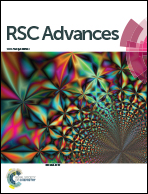Remarkable electrochemical lithium storage behaviour of two-dimensional ultrathin α-Ni(OH)2 nanosheets
Abstract
Transition metal hydroxides are usually ignorable candidates for lithium storage application due to their possible detrimental electrochemical behaviour. Here we focus on two-dimensional (2D) ultrathin α-Ni(OH)2 nanosheets and investigate their electrochemical mechanism as anodes for lithium ion batteries. The employed α-Ni(OH)2 nanosheets show a geometrically graphene-like 2D structure with an ultrahigh surface atomic ratio and large specific surface area of 189.57 m2 g−1. Electrochemical measurements demonstrate a reversible conversion-type electrochemical behaviour with a high activity toward lithium ions. When cycled at 100 mA g−1 current density, the ultrathin α-Ni(OH)2 nanosheets can deliver ultrahigh initial discharge and charge specific capacities of 1744.9 and 1364.6 mA h g−1, with a high initial coulombic efficiency (78.2%). Even at higher current density (200 mA g−1), the initial discharge and charge specific capacities are still retained at 1676.3 and 1301.4 mA h g−1, respectively. The excellent lithium storage could be attributed to the large-area ultrathin 2D nanostructure, which can shorten lithium ion diffusion paths and provide a large exposed surface for more lithium-insertion channels, making it a promising substitute for commercial graphite anode materials in lithium ion batteries.


 Please wait while we load your content...
Please wait while we load your content...